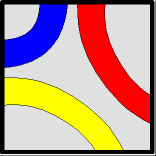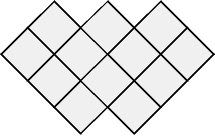



(Linked Side only)
(Unlinked Side)
(Unlinked Side)
(Unlinked Side)
Welcome to the Solution of Rubik's Magic II, which is actually two puzzles in one, and each puzzle is nothing more than an 12-piece jigsaw puzzle (with a bunch of fishing line wrapped around it). You can either solve the side where the five rings hooked together, or solve the side where they are separated apart. You cannot solve both sides at the same time; for as you solve one side the other becomes scrambled. Before trying to solve any side of the puzzle, it is best to educate yourself about the thing by reading this page.
 |
 |
 |
 |
|||
| Signature Tile (Linked Side only) |
Ordinary Triple-Arc Tile (Unlinked Side) |
Ordinary Triple-Arc Tile (Unlinked Side) |
Special Triple-Arc Tile (Unlinked Side) |
|||
Linked Side: The side of the puzzle where the rings are linked. When this side of the puzzle is solved, the rings are all in a straight row, and the puzzle is at the 6x2 rectangular shape.
(On this side, certain tiles have arcs that overlap each other.)
Unlinked Side: The side of the puzzle where the rings are unlinked. When this side of the puzzle is solved, the puzzle is at that eerie zig-zagged shape, and the rings are staggered like they are on the Olympic flag.
(On this side of the puzzle, no arcs overlap each other in any tile.)
Signature Tile: The tile on the Linked Side that has Erno Rubik's signature on it; a very crucial tile of the puzzle.
(Caution: there is another tile on the Unlinked Side that looks very similiar to the Signature Tile on the Linked Side. Try not to confuse the two of them.)
Triple-Arc Tiles: The three tiles on the puzzle that have three arcs on them; two of them look identical and are called Ordinary Triple-Arc Tiles, while one of them is unique and therefore called out as the Special Triple-Arc Tile.
(Note: these tiles are always on the Unlinked Side.)
You've probably noticed that there are numerous troughs that hatch across the surface of each tile. Some troughs are empty, while others are strapped with cords that look like fishing line. Once the puzzle is at the 6x2 shape, one side has cords in the extreme corner troughs, while the other side does not. It is obvious that the cords hold the 12 tiles together, but it is important to recognize which side has corded corners. It is also important to realize that the corded corners can jump from the Linked Side to the Unlinked Side at any given time.
 |
 | Corners with cords | Corners without cords |
 |
 |
The two important flat shapes that can be formed by the puzzle (Other 2-D figures are possible). |
Q: What side is what puzzle?
A: Once the puzzle is in the 6x2 flat shape, study the tiles on both sides. Only one side has the Triple-Arc Tiles, and that defines the Unlinked Side of the puzzle. By process of elimination, the other side must be the Linked Side. Therefore, you don't have to worry about any "you got chocolate in my peanut butter" axioms.
Q: Which tile is the Special Triple-Arc Tile?
A: The Special Triple-Arc Tile has a different color pattern than the other two (otherwise identical) Ordinary Triple-Arc Tiles. Another way to identify the Special Triple-Arc Tile is that it is always 5 tiles away from either of the Ordinary Triple-Arc Tiles (which in turn always have only one tile in between them).